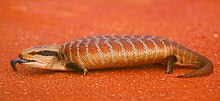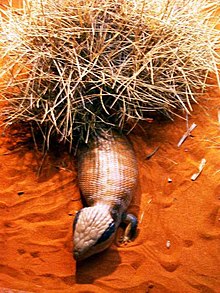Centralian blue-tongued skink
| Centralian blue-tongued skink | |
|---|---|

| |
| Scientific classification | |
| Domain: | Eukaryota |
| Kingdom: | Animalia |
| Phylum: | Chordata |
| Class: | Reptilia |
| Order: | Squamata |
| Family: | Scincidae |
| Genus: | Tiliqua |
| Species: | T. multifasciata
|
| Binomial name | |
| Tiliqua multifasciata Sternfeld, 1919
| |

The Centralian blue-tongued skink or Centralian blue-tongue (Tiliqua multifasciata) is a species of skink,[2] occurring predominantly in the far north-west corner of New South Wales, Australia.[3] It is one of six species belonging to the genus Tiliqua; the blue-tongued skinks and the shinglebacks.
Description
The Centralian blue-tongue is of a very robust build, short body and slender tail, and is among the largest 1% of species in the family Scincidae.[4] Both the forelimb and hindlimb have five digits.[3]
Colouring
The skink is predominantly pale brown to grey in colour with a series of nine or more orange-brown bands along the length of the body and tail. These darker coloured bands are much wider than the paler grey-brown interspaces but are at their narrowest along the mid-dorsal region of the skink.[5] There is a distinguishing black stripe surrounding the eye and extending to just above the ear, and upper-hind areas of limbs are also black.[3][5][6] The skink is pale cream to white on the underside.[3][5]
Distribution
The geographical distribution of the blue-tongued skink lies throughout the far north-west corner of New South Wales and South Australia, and centrally throughout Western Australia, the Northern Territory and Queensland.[5][6] In general, habitats include a variety of arid and semi-arid stony and red sandy spinifex vegetated areas.[6]
Behaviour
Like many other reptilian species, the blue-tongued is a fairly sedentary terrestrial creature.[7] It is a ground-dwelling, diurnal species[5] and displacements are relatively short (less than 20 metres) and on average the total distance travelled each day can fall between 122 and 245 metres.[7]
Diet
Analyses of stomach contents have shown that the blue-tongue feeds on a combination of seeds, insects, livestock dung and some vertebrate and invertebrate material such as that of bird or other reptilian remains (i.e. fragments of bone, loose feathers).[4]
Reproduction
Along with the other five species of the same genus, the Centralian blue-tongued skink is a viviparous species – it bears between two and 10 live young in a single litter.[3][5][6]
Threats
The geographical location of the skink sees one of its major threats to be ingestion of the invasive and toxic cane toad,[8] but it is also under pressures from other anthropogenic processes such as fire and habitat fragmentation.[7] However, the species is still currently listed as least concern.[1]
References
- ^ . Retrieved 26 October 2021.
- ^ Tiliqua multifasciata at the Reptarium.cz Reptile Database. Accessed 20 December 2016.
- ^ ISBN 095902039X.
- ^ .
- ^ OCLC 43580360.
- ^ ISBN 187633472X.
- ^ S2CID 85826862.
- doi:10.1071/WR09170.

